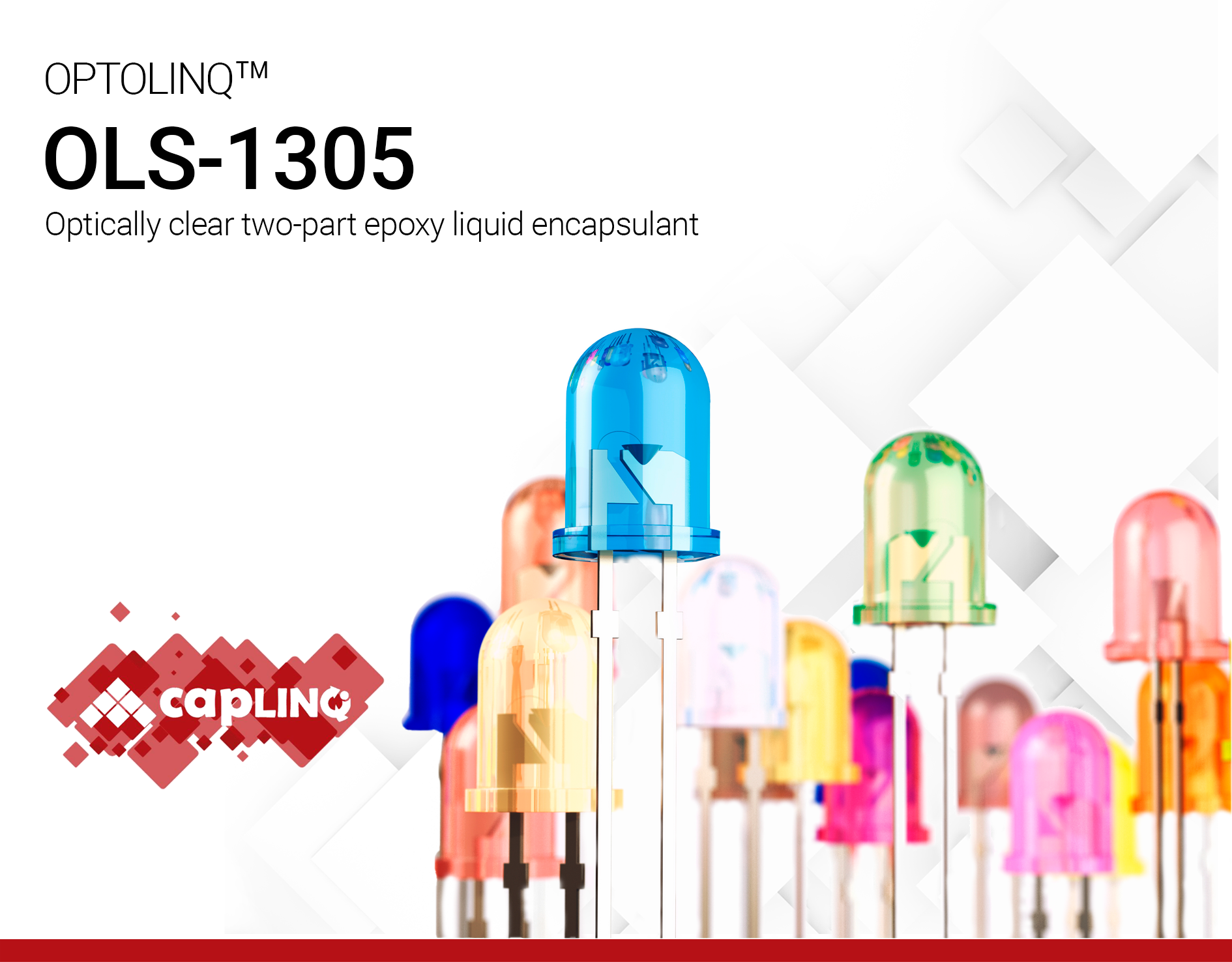OLS-1305 | Liquid Encapsulant - Two part Epoxy
- Extremely low viscosity
- Rapid cure at moderate temperatures
- Excellent mechanical properties
Product Description
OPTOLINQ OLS-1305 is an optically clear, two-part epoxy resin designed for chip encapsulation. This material exhibits exceptionally low viscosity and excellent air bubble release capabilities. It can cure rapidly even at moderate temperatures while demonstrating low shrinkage throughout the curing process. OLS-1305 has high mechanical strength, good adhesion strength on different surfaces, and high resistance against moisture and heat. It is highly resistant to aging from light and heat exposure. When fully cured, OLS-1305 exhibits uniform transparency and retains its color, making it an ideal material for the encapsulation of optoelectronic devices.
Technical Specifications
| General Properties | |||||
| Work life @25°C Work life @25°C Work life is the amount of time we have to work with a material until it is no longer able to be easily worked and applied on a substrate. It is based on the change in viscosity and it can rely on the application requirements. | 4 hours | ||||
| Physical Properties | |||||
| Viscosity Viscosity Viscosity is a measurement of a fluid’s resistance to flow. Viscosity is commonly measured in centiPoise (cP). One cP is defined as the viscosity of water and all other viscosities are derived from this base. MPa is another common unit with a 1:1 conversion to cP. A product like honey would have a much higher viscosity -around 10,000 cPs- compared to water. As a result, honey would flow much slower out of a tipped glass than water would. The viscosity of a material can be decreased with an increase in temperature in order to better suit an application | 150–350 mPa.s | ||||
| Chemical Properties | |||||
| Water Absorption | 0.3 % | ||||
| Mechanical Properties | |||||
| |||||
| Thermal Properties | |||||
| |||||
| Glass Transition Temperature (Tg) Glass Transition Temperature (Tg) The glass transition temperature for organic adhesives is a temperature region where the polymers change from glassy and brittle to soft and rubbery. Increasing the temperature further continues the softening process as the viscosity drops too. Temperatures between the glass transition temperature and below the decomposition point of the adhesive are the best region for bonding. The glass-transition temperature Tg of a material characterizes the range of temperatures over which this glass transition occurs. | 122–132 °C | ||||
Additional Information
Processing Instructions
- Mix component A and B, stir uniformly, and defoam for 5 minutes.
- Prior to chip encapsulation, it is recommended to dry the chip at 150 °C for 2–4 hours and then treat the chip surface using plasma.
- The recommended curing conditions is 150 °C for 4–6 hours. Identify the specific curing settings based on your product requirements.
Precautions
- Do not preheat Parts A and B as exposure to high temperatures may shorten their usable time.
- Utilize the mixture promptly after mixing components A and B to avoid excessive viscosity.
- After dispensing, immediately commence the baking process to avoid moisture absorption, which can slow down the drying process and make the cured product brittle. It is recommended to maintain the relative humidity at approximately 70% when handling the product.
- Store the curing agent (component B) in sealed jars to prevent moisture absorption and sedimentation.
- Precipitates may form in the color pastes when they are stored for an extended period of time. As such, prior to use, color pastes must be heated at 60–90 °C until the solid sediments are completely dissolved to ensure uniform color distribution during dispensing.
- For foam reduction, a defoaming agent may be added, not exceeding 0.3% of the total AB mixture weight.
- Avoid skin and eye contact. In case of contact, rinse thoroughly with soap (for skin) or clean water (for eyes), and seek medical attention if needed.
- Maintain a clean and ventilated workplace, using extraction trunks when necessary.
- Wear appropriate protective equipment and minimize direct contact with the human body. Refer to the Material Safety Data Sheet (SDS) before use.
Please note that the provided information is based on available data and typical conditions. For specific applications and detailed test results, refer to the actual test data and conduct appropriate certifications.
Using Additives
Optolinq OLS-1305 can be mixed with diffusing agents or color pastes to achieve customer-specific purposes.
Recommended quantity of various diffusing agents and color pastes:
- OPC-R Red Color Paste: 0.1-0.5% by epoxy weight
- OPC-B Blue Color Paste: 0.1-0.5% by epoxy weight
- OPC-G Green Color Paste: 0.1-0.5% by epoxy weight
- ODF-090 Diffusing Agent: 3-5% by weight (LED lamps), 4-8% (LED displays)
Storage and Handling
Store in a ventilated, dry, and clean environment below 25°C. Keep away from fire and heat sources. It is strictly forbidden to store in outdoor environments. At proper storage conditions, Part A has a shelf life of 6 months and Part B a shelf life of 3 months. Shelf life can be extended by using cold storage.



